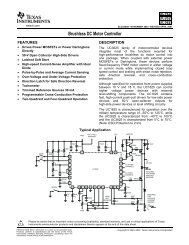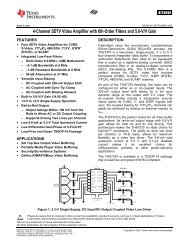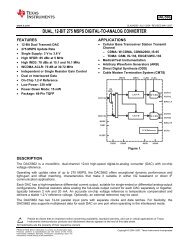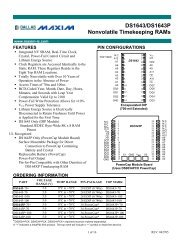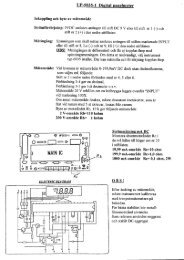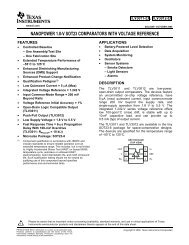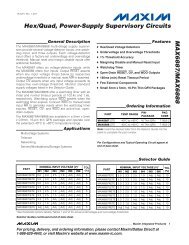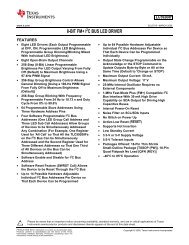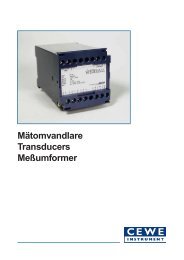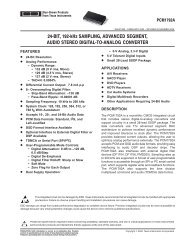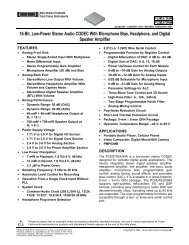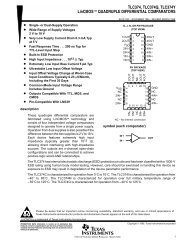Single-Chip Low Power RF Transceiver for Narrowband Systems ...
Single-Chip Low Power RF Transceiver for Narrowband Systems ...
Single-Chip Low Power RF Transceiver for Narrowband Systems ...
You also want an ePaper? Increase the reach of your titles
YUMPU automatically turns print PDFs into web optimized ePapers that Google loves.
CC1021<br />
MODEM Register (0Dh)<br />
REGISTER NAME Default<br />
value<br />
Active Description<br />
MODEM[7] - 0 - Reserved, write 0<br />
MODEM[6:4] ADC_DIV[2:0] 3 - ADC clock divisor<br />
0: Not supported<br />
1: ADC frequency = XOSC frequency / 4<br />
2: ADC frequency = XOSC frequency / 6<br />
3: ADC frequency = XOSC frequency / 8<br />
4: ADC frequency = XOSC frequency / 10<br />
5: ADC frequency = XOSC frequency / 12<br />
6: ADC frequency = XOSC frequency / 14<br />
7: ADC frequency = XOSC frequency / 16<br />
MODEM[3] - 0 -<br />
Note that the intermediate frequency should be as close<br />
to 307.2 kHz as possible. ADC clock frequency is always<br />
4 times the intermediate frequency and should there<strong>for</strong>e<br />
be as close to 1.2288 MHz as possible.<br />
Reserved, write 0<br />
MODEM[2] PN9_ENABLE 0 H Enable scrambling of TX and RX with PN9 pseudo-<br />
random bit sequence<br />
0: PN9 scrambling is disabled<br />
9 5<br />
1: PN9 scrambling is enabled (x +x +1)<br />
MODEM[1:0] DATA_FORMAT[1:0] 0 -<br />
The PN9 pseudo-random bit sequence can be used<br />
<strong>for</strong><br />
BER testing by only transmitting zeros, and then<br />
counting the number of received ones.<br />
Modem data <strong>for</strong>mat<br />
0 (00): NRZ operation<br />
1 (01): Manchester operation<br />
2 (10): Transparent asynchronous UART operation,<br />
set<br />
DCLK=0<br />
3 (11): Transparent asynchronous UART operation,<br />
set<br />
DCLK=1<br />
DEVIATION Register (0Eh)<br />
REGISTER NAME Default<br />
value<br />
Active Description<br />
DEVIATION[7] TX_SHAPING 1 H Enable Gaussian shaping of transmitted data<br />
Recommended setting: TX_SHAPING=1<br />
DEVIATION[6:4] TXDEV_X[2:0] 6 - Transmit frequency deviation exponent<br />
DEVIATION [3:0] TXDEV_M[3:0] 8 - Transmit frequency deviation mantissa<br />
Deviation in 402-470 MHz band:<br />
FREF ·TXDEV_M ·2 (TXDEV_X−16)<br />
Deviation in 804-940 MHz band:<br />
FREF ·TXDEV_M ·2 (TXDEV_X−15)<br />
On-off-keying (OOK) is used in RX/TX if TXDEV_M[3:0]=0<br />
To find TXDEV_M given the deviation and TXDEV_X:<br />
TXDEV_M = deviation·2 (16−TXDEV_X) /FREF<br />
in 402-470 MHz band,<br />
TXDEV_M = deviation·2 (15−TXDEV_X) /FREF<br />
in 804-940 MHz band.<br />
Decrease TXDEV_X and try again if TXDEV_M < 8.<br />
Increase TXDEV_X and try again if TXDEV_M ≥ 16.<br />
SWRS045B Page 71 of 89



